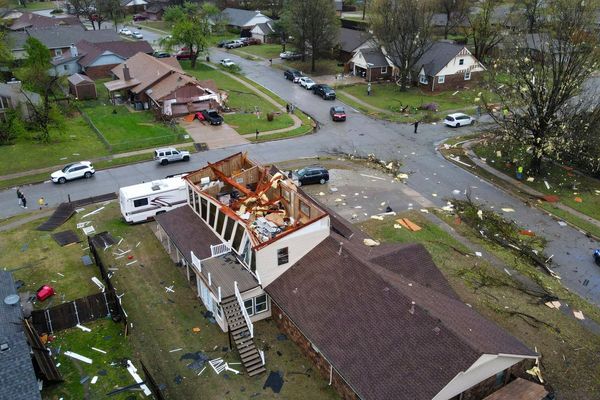Rainbow-coloured boughs bent by snow are a familiar sight in the Australian Alps in winter.
But there is nothing like sitting in the soft grass on the high plains under the dappled shade of an old snow gum on a beautiful summer's day, says James Camac.
"Out of all the eucalypt species in Australia, I think it is by far one of the most beautiful," says Dr Camac, an ecologist from the University of Melbourne.
"It's a gorgeous, gnarly looking eucalypt, particularly the really old ones in the landscape."
But those who know the high plains of the Australian Alps can see these views changing before their eyes.
Snow gums (Eucalyptus pauciflora) thrive in cooler, wetter conditions.
Australia's six sub-species of snow gums grow in isolated pockets of mountains from Victoria, to southern Queensland, as well as Tasmania.
While they can grow above the snowline, they can also be found as low as Bega on the south coast of New South Wales.
But as temperatures warm, these iconic trees are being threatened by drought, fire and disease.
Moving up the mountains
In the northern hemisphere, trees are moving to higher altitudes in mountain areas to beat rising temperatures, but there is very little wriggle room for snow gums in Australia.
"The challenge is they can't really go down the mountain, because they can't compete with the faster-growing, taller species that will overshadow them, and they've only got a relatively small range to be able to move up the mountain into more suitable conditions as the climate changes," Dr Camac says.
So far, the tree line has barely changed in the mountains where snow gums grow, Dr Camac says.
"In some locations such as Mount Hotham, the tree line may have expanded over the course of a decade by between five and 10 metres, which is not actually keeping in line with the changing climate," he explains.
While marginal shifts in tree line are seen in areas that haven't been burnt by fire, warming temperatures also encourage plant growth in the heathland, making the high country more fire-prone.
"If we get more frequent fires caused by lightning strikes, there's going to be potentially fewer opportunities for snow gums to actually establish, particularly beyond the tree line," Dr Camac says.
Fire survival strategies
Snow gums are better adapted to fire than some other mountain species like alpine ash (Eucalyptus delegatensis), which only recovers from seed.
Even though fire takes out the crowns of snow gums, established trees can resprout from an underground lignotuber that stores carbohydrates.
"That's why you'll get these big, dead-looking trees, but you've got a massive resprout coming up from the base," Dr Camac says.
"Eventually the original stem or trunk will decay and fall away and be replaced by the new resprouts."
But, he says, as the frequency and intensity of fires roaring up from the foothills increases, older more iconic trees are less likely to survive.
"When people think of snow gums, they think of the 100-plus year-old giant individuals in the landscape, and if the fires go through and kill them, then basically you've just got these small, not particularly charismatic-looking individuals."
It can take 30–40 years for the landscape to look the same as it once did if the trees are not burnt again in quick succession.
"People who go up now after Black Summer fires in Kosciuszko [National Park] will see what looks like all these dead trees, and they're going to have to get used to that for the next 30-plus years," Dr Camac says.
"I've had colleagues that have been working up there for the best part of 50 years and they were like 'I'll never see it as it was again'".
While the trees can bounce back in time after one fire, studies show they are less likely to resprout, and new seedlings are less likely to grow, after a second, and particularly a third fire.
Dr Carmac says the proportion of the Australian Alps that's burnt multiple times in 50 to 100 years is fairly small.
But some areas in the Victorian Alps, such as the Dargo High Plains, have had two to three fires in quick succession.
"I've been on sites that have burnt more than three times, and they are barren with erosion," he says.
Battling beetle infestations
To complete the trifecta, the trees face another threat in the form of a small, native beetle.
The Phoracantha beetle has infested large tracts of snow gums living in high elevations above 1,600 metres, right across the Alps from Victoria to the ACT.
It is also affecting another species known as the weeping snow gum (Eucalyptus lacrimans), which only grows in a small area lower down the mountains near the town of Adaminaby in southern New South Wales.
Unlike the leaf-eating eucalyptus weevil killing ribbon gums (Eucalyptus viminalis) across the Monaro Plains on the eastern foothills of the Snowy Mountains, the wood-boring Phoracantha ring-barks its victims.
Death is slow. And no tree, no matter what age, is safe, says Matt Brookhouse of the Australian National University.
The beetle starts by sucking the life out of the tree's crown. In response, the tree sends out more shoots beneath the dead area. But by the time the new shoots appear, the beetle is often ready and waiting to immediately cut off the new growth.
The cycle of death, resprouting, and death continues, but eventually the tree's carbohydrate reserve dries up.
"After a fire, even in the worst cases, you have trees sprouting from lignotubers," Professor Brookhouse says.
"After a tree has been the focus of a sustained wood borer infestation the capacity to regenerate is lost."
While research is ongoing, Professor Brookhouse says the overwhelming evidence suggests these wood borers thrive when water in the atmosphere drops causing the bark to dry out.
"Much like a moat around a castle, it's that live wet tissue that surrounds the tree bowl that keeps it alive," he explains.
The tissue also keeps fungi and insects out and once that protection weakens, the tree's in real trouble, he adds.
The final coup d'etat
So what happens when drought stress, beetles and fire are combined?
Fire can wipe out an emerging beetle infestation by killing the above-ground portion of the tree.
But if a tree has been under a sustained attack for several years, fire may be the final coup d'etat.
"We don't have enough monitoring data to conclude which way a fire is going to push an individual tree," Professor Brookhouse says.
The wood-boring beetles also tend to infest trees that have recovered from bushfires years earlier.
"So fire itself may have a legacy effect that may encourage insect infestations."
And to complete the loop, by leaving dead trees standing, the beetles can contribute to fuel load.
"We have recently dated standing trees in Thredbo that were killed by Phoracantha in the early 1950s," Professor Brookhouse says.
"That was a very small outbreak … the outbreak we see now is well and truly beyond anything we've seen before."
The problem has become so bad along one of his favourite walks between Guthega and Illawong Hut in the Snowy Mountains, that all the trees have died.
"I think I could have swallowed it if it was a fire, but it's just catastrophic," he says.
"And it's not a matter of these trees are going to grow back — they're dead.
"The sight of that really broke me, it was just awful."
The mountains have been wetter over the past couple of years, but it is likely to be only a temporary reprieve against beetle attack.
"The insects have a life span, we think, of at least three years so if we get three good wet years in a row, that will be immensely helpful," Professor Brookhouse says.
But, he says, dieback declined in wetter windows in the past such as 2010 and 2011, but then returned full force when conditions dried out again.
While warmer periods can boost growth, it gives the beetles lots to chew on as soon as conditions dry.
"I have no doubt they'll still be there the next time severe drought emerges, and I would expect that we'd see another explosion.
"That's not a comforting thought, but at the very least, I think we have a year or two now to work through possible responses to it."
Action needed now
One of those responses is to trial planting lower sub-species of snow gums that are not currently affected by the insect into the ranges of the higher elevation sub-species.
Professor Brookhouse says it's hard to know why the lower sub-species of snow gums are not affected by the beetle, but it could be due to physiological differences.
Trees that live at higher elevations leave the stomata on their leaves open to capture as much CO2 as they can during the freezing winters.
This also means they may lose more water during summer, making them more vulnerable to attack.
"It's fair to say, though, that at this stage we don’t know, but we will begin working towards an answer with greenhouse trials later this year," Professor Brookhouse says.
The physiological difference between the sub-species may also make it harder to know whether low elevation species can survive above the snow line.
"But we're now at a point at which — and this might sound strange for a researcher to say — we can't to some extent wait for research outcomes to tell us which way to jump, we need to make some decisions now based upon what it looks like," Professor Brookhouse says.
Without doing so, he argues, the trees might not get an opportunity to move up higher to escape rising temperatures.
"At this point, the tree line is not going to get the chance [to move up], because it simply cannot move fast enough to outrun the insects that are on their way up."
If the iconic snow gum disappears from an area, the landscape alters, and vital animal habitats are lost.
For people who have spent most of their lives in the mountains like Professor Brookhouse, these changes have a deep impact.
“When you have a strong connection to a place and it's altered ... part of your identity that's very much tied to your home and those places is lost in that moment,” he says.
Catalyst is exploring the extraordinary lives of eight of Australia's oldest, largest and most iconic trees — watch part one on ABC iview.
Part two, where an expert judging panel will select their favourite tree, airs at 8:30pm on Tuesday, August 23 on ABC TV and ABC iview.







